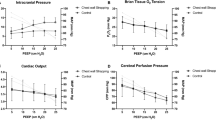Summary
Seventeen piglets of both sexes, seven with O2/air-buprenorphine anaesthesia and controlled ventilation, and ten unanaesthetized animals with normal, spontaneous respiration, were used for the study. The intracranial pressure of both groups of animals was raised by insufflation of an epidural ballon and the arterial blood pressure was reduced to approximately 70% of the original value by controlled haemorrhage. 0.5 mg/kg body weight of ketamine was given intravenously, followed by a further dose of 2.0 mg/kg body weight of ketamine five minutes later.
Both ketamine doses led to a significant rise in the intracranial pressure of those animals breathing spontaneously (31.8 mm Hg to 39.1 mm Hg). In contrast, the ventilated animals showed a significant reduction in intracranial pressure. No changes in arterial PCO2 were observed in this group, while those piglets breathing spontaneously had dangerous PCO2 rises. At both ketamine doses a significant correlation could be found between the PCO2 and the intracranial pressure.
Similar content being viewed by others
References
Bermann, I. R., Duck, T. B., Pulmonary, somatic and splanchnic circulatory responses to increased intracranial pressure. Ann. Surg.169 (1969), 210–216.
Bogetz, M. S., Weiskopf, R. B., Roizen, M. F., Ketamine increases catechols, but causes cardiovascular depression and acidosis in hypovolemic swine. Anesthesiology57 (1982), A 29.
Bond, A. C., Davie, C. K., Ketamine and pancuronium for the shocked patient. Anaesthesia29 (1974), 59–62.
Chasapakis, G., Kekis, N., Sakkalis, C., Use of ketamine and pancuronium for anesthesia for patients in hemorrhagic shock. Anesth. Analg.52 (1973), 282–287.
Dick. W., KetanestR (Ketamine). Notfallmed.9 (1983), 847–849.
Fessl-Alemany, E., Clar, H. E., Gobiet, W., Untersuchungen der intrakraniellen Druckverhältnisse des Kaninchens unter Ketamin. In: Ketamin (Gemperle, M., Kreuscher, H., Langrehr, D., Hrsg.), pp. 214–217. Berlin-Heidelberg-New York: Springer. 1973.
Gardner, A. E., Olson, B. E., Lichtiger, M., Cerebrospinal fluid pressure during dissociative anesthesia with ketamine. Anesthesiology35 (1971), 226–228.
Giamangeli, A., Recchia, M., Rocchetti, M., SPB: Programs for non-parametric tests. Computer programs in biomedicine16 (1983), 43.
Gibbs, J. M., The effect of intravenous ketamine on cerebrospinal fluid pressure. Br. J. Anaesth.44 (1972), 1298–1301.
Grote, W., Schädel-Hirn-Verletzungen. In: Mehrfachverletzungen. (Streicher, H. J., Rolle, J., Hrsg.), pp. 156–169. Berlin-Heidelberg-New York: Springer. 1980.
Hougaard, K., Hansen, A., Brodersen, P., The effect of ketamine on regional cerebral blood flow in man. Anesthesiology41 (1974), 562–567.
Idvall, J., Influence of ketamine anesthesia on cardiac output and tissue perfusion in rats subjected to hemorrhage. Anesthesiology55 (1981), 297–303.
Kindt, G. W., Gosch, H. H., Arterial PCO2 effect at various levels of intracranial pressure. In: Intracranial Pressure (Brock, M., Dietz, H., eds.), pp. 210–213. Berlin-Heidelberg-New York: Springer. 1972.
Klose, R., Hartung, H. J., Kotsch, R., Walz, Th., Experimentelle Untersuchung zur intrakraniellen Drucksteigerung durch Ketamine beim hämorrhagischen Schock. Anaesthesist31 (1981), 33–38.
List, W. F., Crumrine, R. S., Cascorbi, H. F., Weiss, M. H., Increased cerebrospinal fluid pressure after ketamine. Anesthesiology36 (1972), 98–99.
List, W. F., Cascorbi, H. F., Druckanstieg im Liquor cerebrospinalis unter Ketamin. In: Ketamin (Gemperle, M., Kreuscher, H., Langrehr, D., Hrsg.), pp. 218–222. Berlin-Heidelberg-New York: Springer. 1973.
Longnecker, D. E., Sturgill, B. C., Influence of anesthetic agent on survival following hemorrhage. Anesthesiology45 (1976), 516–521.
Peter, K., Dietze, W., Frey, B., Klose, R., Mayr, J., Hämodynamische Veränderungen im Schock bei intravenöser Narkoseeinleitung mit Ketamin. In: Ketamin (Gemperle, M., Kreuscher, H., Langrehr, D., Hrsg.), pp. 120–124. Berlin-Heidelberg-New York: Springer. 1973.
Pfenninger, E., Flunitrazepam und intrakranieller Druck. Anästh. Intensivmed.22 (1981), 321–326.
Pfenninger, E., Dick, W., Grünert, A., Lotz, P., Tierexperimentelle Untersuchung zum intrakraniellen Druckverhalten unter Ketamineapplikation. Anaesthesist33 (1984), 92–88.
Schalk, H. V., List, W. F., Liquordruckentwicklung nach Ketamin. In: Ketamin (KetanestR) in Notfall- and Katastrophenmedizin (Dick, W., Hrsg.), pp. 71–76. Erlangen: Perimed. 1981.
Schwedler, M., Miletich, D. J., Albrecht, R. E., Cerebral blood flow and metabolism following ketamine administration. Can. Anaesth. Soc. J.29 (1982), 222–225.
Shapiro, H. M., Wyte, S. R., Harris, A. B., Ketamine anaesthesia in patients with intracranial pathology. Br. J. Anaesth.44 (1972), 1200–1204.
Stefánsson, T., Wickström, I., Haljamäe, H., Hemodynamic and metabolic effects of ketamine anesthesia in the geriatric patient. Acta Anaesthesiol. Scand.26 (1982), 371–377.
Takeshita, H., Okuda, Y., Sari, A., The effects of ketamine on cerebral circulation and metabolism in man. Anesthesiology36 (1972), 69–73.
Tanaka, K., Nishimura, H. S., Matsuura, S., Changes of the sympathetic vasomotor activity during increased intracranial pressure. In: Intracranial Pressure III. (Beks, J. W. F., Bosch, D., Brock, M., eds.), pp. 50–56. Berlin-Heidelberg-New York: Springer. 1976.
Taube, H. D., Gobiet, W., Liesegang, J., Bock, W. J., Intrakranielle Druckverhältnisse unter Ketamin. In: Ketamin (Gemperle, M., Kreuscher, H., Langrehr, D., Hrsg.), pp. 223–227. Berlin-Heideiberg-New York: Springer. 1973.
Tranquilli, W. J., Thurmon, J. C., Benson, G. J., Organ blood flow and distribution of cardiac output in hypocapnic ketamineanesthetized swine. Am. J. Vet. Res.44 (1983), 1578–1582.
Waxman, K., Shoemaker, W. C., Lippmann, M., Cardiovascular effects of anesthetic induction with ketamine. Anesth. Analg.59 (1980), 355–358.
Wyte, S. R., Shapiro, H. M., Turner, P., Harris, A. B., Ketamineinduced intracranial hypertension. Anesthesiology36 (1972), 174–176.
Zattoni, J., Siani, C., Effects of some anesthetic drugs on the ventricular fluid pressure and on the systemic blood pressure both arterial and venous. In: Intracranial Pressure (Brock, M., Dietz, H., eds.), pp. 297–302. Berlin-Heidelberg-New York: Springer. 1972.
Author information
Authors and Affiliations
Rights and permissions
About this article
Cite this article
Pfenninger, E., Grünert, A., Bowdler, I. et al. The effect of ketamine on intracranial pressure during haemorrhagic shock under the conditions of both spontaneous breathing and controlled ventilation. Acta neurochir 78, 113–118 (1985). https://doi.org/10.1007/BF01808689
Issue Date:
DOI: https://doi.org/10.1007/BF01808689




